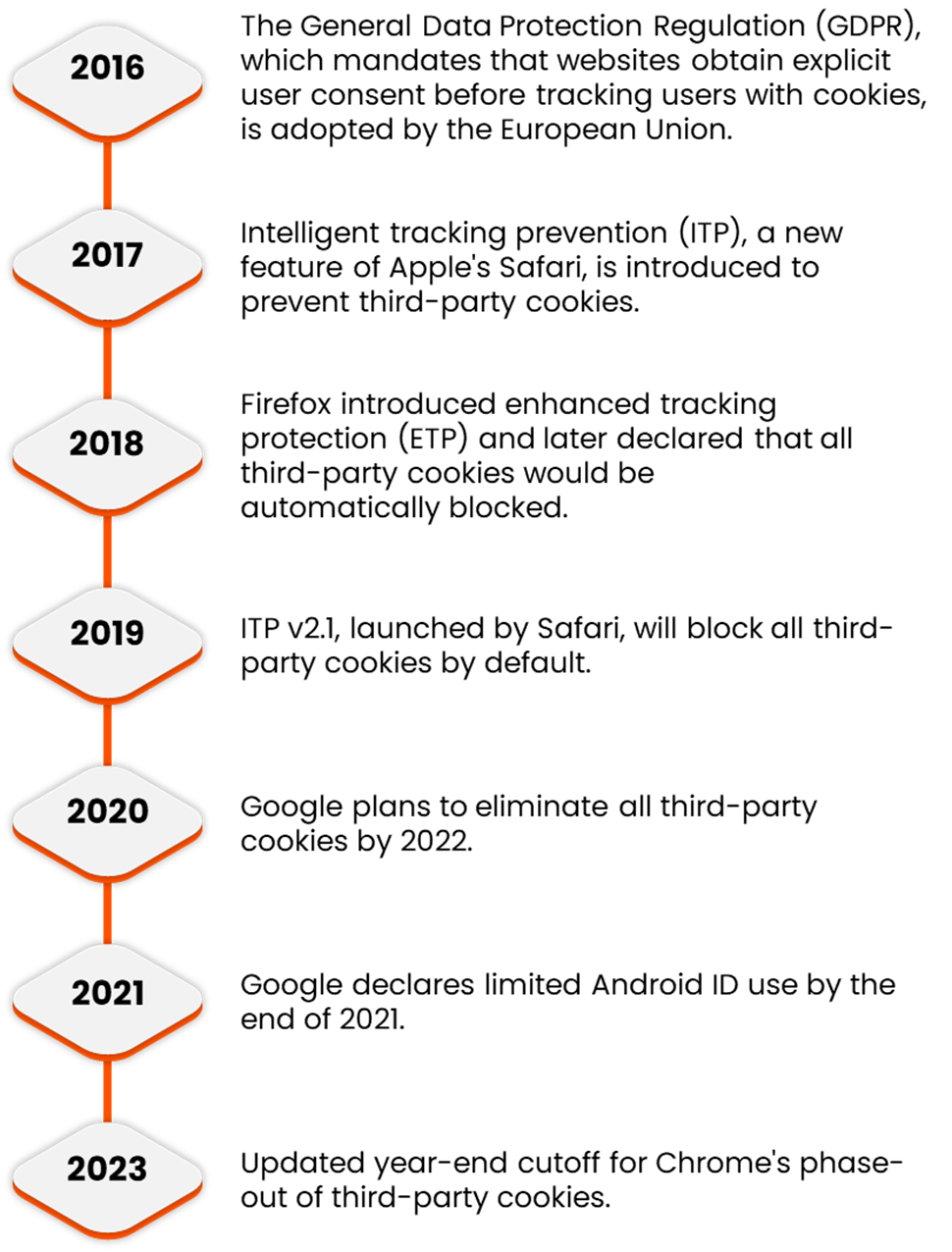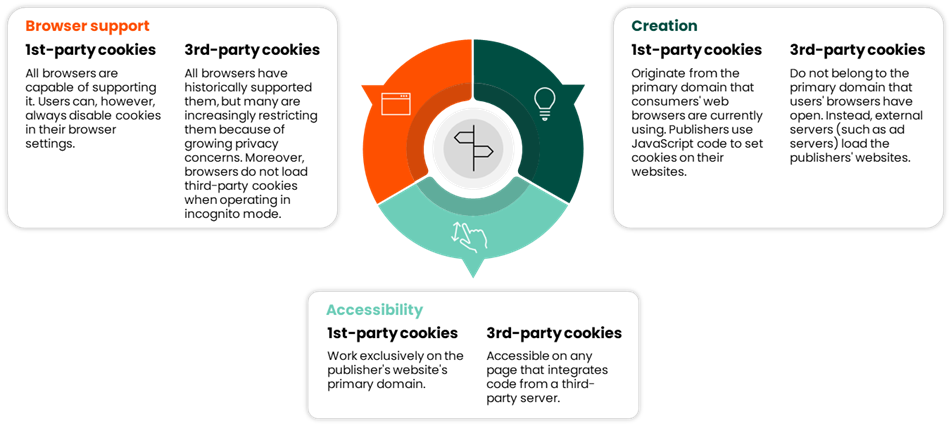
The internet has had a logarithmic growth since its inception in the 1960s. From a mere data exchange platform, it is now a multifaceted source for knowledge, socialization, business, and entertainment, meaningfully having one of the greatest impacts on shaping the customer experience. In 2022 alone, global internet users spent an average of 7 hours online daily, with nearly 5.07 billion people connected worldwide.
This transformation would not have been possible without giving the web a memory – making it more personal and allowing for secure e-commerce transactions. And therefore, cookies were developed. Cookies store user behavior, allowing websites to tailor ads & create personalized customer experiences. Their use is ubiquitous: almost 42% of websites use cookies to track visitors, increasing conversions by up to 300%. They're stored in every device & have enabled businesses to revolutionize their marketing strategies & maximize their ROI through customer analytics.
For two decades, publishers have provided digital content funded by advertisers' ads, trading user data for access. Over $521B was spent in 2022 on a digital advertisement. Users provide information willingly/unwittingly to gain content, creating a symbiotic relationship where everyone wins. In addition, customer experience analytics helps understand user behavior, drive targeted advertising campaigns, and improve customer experience.
Now, the end of third-party cookies has the potential to disrupt traditional data-based performance advertising, leaving advertisers and publishers without a reliable way to identify target audiences and measure campaign performance.
Customer analytics will become even more critical in the cookie-free world, helping businesses understand their target audience and personalize content. This could result in billions of forfeited revenues for the digital advertising industry. Marketers should be aware of the changes and how to prepare for a cookie-free world, such as embracing alternative tracking solutions like contextual targeting, first-party data management platforms, probabilistic modeling, or leveraging mobile app user IDs. With careful planning and adaptation, advertisers can maintain successful online campaigns despite the absence of cookies.
It's also crucial for marketers to comprehend how a cookie-free world would affect digital advertising and how to prepare for it, with a focus on customer experience at the forefront.
Bridging the gap between customer experience and brands
Customer experience (CX) has become essential for brands to stand out and keep their customers loyal. For example, 75% of customers are willing to pay more for excellent service companies, and 50% will switch after a bad experience. Despite this, many businesses still rely on old-fashioned information from unknown sources. To stay ahead, organizations must create personalized CX strategies that offer real value to customers, utilizing customer analytics to drive better decision-making.
Studies show that doing this can result in up to 15% revenue growth and a 70% increase in customer loyalty. In addition, investing in modern tools such as AI-driven analytics systems can help brands acquire data-driven insights to deliver truly personalized CX and gain a competitive edge.
Unraveling third-party cookies
Websites use cookies to remember a user's action so they don't have to redo it. They thereby assist in delivering a better, more personalized user experience, contributing to an enhanced customer experience.
Particularly, third-party cookies are made and set by websites other than the one you're viewing. Cross-site tracking, retargeting, and ad-serving are a few common uses, all of which rely on customer segmentation for optimal performance.
- Cross-site tracking — the process of gathering information about your online behavior by collecting browsing data from multiple sources (websites)
- Retargeting — Retargeting visitors with visual or text adverts depending on their search behavior and the products and services they've shown interest in, leveraging customer analytics to make these advertisements more relevant
- Ad-serving — Determining when to show advertisements, deciding which ads should appear on a website, and gathering data (and reporting said data, including impressions and clicks), all to inform advertisers about consumer insights, customer analytics, and ad effectiveness.
On the other hand, the host domain creates first-party cookies. Since they contribute to a better user experience, they are widely considered helpful. These cookies allow the browser to remember crucial user data, such as what you put in your shopping cart, username and password, and preferred language.
For example, suppose you go to the website learn.com; first-party cookies are placed on this website by life.com. Third-party cookies are any cookies placed on life.com by any other website, such as a social media platform or an advertisement.
Third-party cookies function by integrating JavaScript from one website into another. Cookies from third parties keep track of information between browsing sessions. Because HTTP, the online browsing protocol, is a stateless framework, people tend to recall information in this fashion. Therefore, data is not retained between browser sessions in a "stateless protocol." Whether a cookie is a first- or third-party cookie is determined by cookie properties in the HTTP response header.
Breaking down the events leading to the demise of third-party cookies
Breaking down the events leading to the demise of third-party cookies
Cookies have been crucial to the internet marketer's toolkit for many years. It is also essential in shaping customer experience and providing valuable customer insights. Studies revealed that 32% of business decision-makers foresee declining income due to third-party cookie bans. With targeted advertisements, marketers can follow users across websites thanks to snippets of code that uniquely identify a user's browser. These snippets of code also help a wide ecosystem of MarTech organizations collect consumer behavior data and make it available to marketers. For data-driven marketing strategy and initiatives, there are thousands of data platform providers today, spanning consumer, data management, and data exchange platforms.
However, consumers concerned about data privacy are increasingly speaking out against cookies. In 2013, browsers like Firefox and Safari began prohibiting third-party cookies. And in 2019, Safari took things a step further by disabling all cookies after seven days, effectively eliminating the ability to use even first-party cookies to track users over time.
Google has always been a game-changer in the digital world, and its most recent move is no different. In January 2020, in a similar vein, Google confirmed it would also eliminate third-party cookies from Chrome. The tech giant has announced it will no longer develop or support any browser technology that tracks individuals' web activity. This is a big deal, considering that Google controls a large portion of the browser market. Chrome has 64% of the browser market share, while Android accounts for 85% of the smartphone market. This move by Google will surely have a ripple effect throughout the digital landscape.
Notable events that lead to the end of third-party cookies:

How will the demise of third-party cookies impact digital advertising?
About 80% of advertisers rely on third-party cookies, and 67% are displeased, frustrated, overwhelmed, helpless, and even perplexed by the news that they will soon no longer be used.
The following components of advertising will be most influenced by third-party cookie abolition:
- Reach — Advertisers will need to find a new online customer and prospect communication method once cookies are removed.
- Personalization — It will be difficult for advertisers who rely on third-party cookies to customize adverts since behavioral and surfing data will be restricted.
- Campaign Management — Advertising companies that rely on third-party cookies will find it difficult to implement fundamental features like A/B testing and frequency capping.
- Performance Measurement — Third-party cookie-based analytics and attribution will be much less effective.
Making the most out of non-third-party cookies
Develop these alternate sources to gather data about your customers and achieve comparable levels of personalization while weighing privacy issues.
Double down on the first part data collected with consent
Companies need to focus on first-party data and permission-based advertising to succeed in a cookie-less world. This means obtaining users' informed consent before acquiring their data. By doing so, businesses can create a better relationship with their audience and provide them with more relevant content and ads.
First-party data can be gathered directly from users by you through your website and other interactions, or it can be collected on your behalf by an advertising agency through a survey or ad performance. As third-party cookie data gets older, this information will become highly important.
When used effectively, first-party data can help publishers, marketers, and other stakeholders map out user behavior for more effective ad targeting and intent data assessment.
ADVICE: Marketers who are tasked with gathering first-party data ought to —
- Create a variety of engaging touchpoints to gather essential information during the purchasing process. For example, users could be persuaded to share data by loyalty programs, incentives, and information that offers solutions.
- Before gathering the data, determine whether you have the infrastructure and skills for data and analytics.
- Map out your reliance on cookie data and calculate its effect on expenses and income. It will assist you in determining how much to risk using your data collection techniques.
Establish direct relationships with large publishers
Partnering with reputable, established publishers who gather first-party data from sources inside and outside your business is a good way to utilize alternative data sources without making a significant investment. Publishers who have been in the industry for a while have good relationships with other businesses and individuals who can provide you with accurate and timely data.
The number of information publishers and review websites can give them insight into the interests of their audience. This data can be used to improve the planning and measurement of marketing initiatives.
When first-party data is sourced in this way, it becomes second-party data. Finding a way to share secondary data while maintaining user privacy is one issue facing marketers gathering this data. For example, some high-value-add options integrating anonymous data from various parties include collaborative clean rooms and divergent privacy.
ADVICE: Marketers utilizing direct publisher agreements should —
- Look for publishing sites your target audience frequents and relies on to make purchases. While major publication platforms like Google, Facebook/Meta, and LinkedIn exist, software developers could discover that technology review websites make better business partners.
- Utilize platforms that have large volumes of user data collected from surveys, consumer evaluations, and online forms.
Contextual advertising for non-personal targeting
Contextual advertising is another option for marketers to consider if permission solutions fall short, especially for upper-funnel objectives like awareness.
Contextual advertising is a type of advertising that considers the webpage's content to position ads. This is done with the expectation that people with similar traits will access that content.
79% of consumers prefer contextual advertisements to behavioral ads.
Eliminating the need for agreement expands advertising beyond personal targeting and develops tailored marketing.
ADVICE: Marketers engaging in contextual advertising should —
- Utilize content analysis to create taxonomies that, at the very least, partially automate the advertising process, making reaching your intended target audience simpler.
- Regarding advertisement usage, encode structured content descriptions to make ad measurement smoother and more reliable.
Key differences between 1st- & 3rd- party cookies
First-party and third-party cookies are the same types of data from a technical standpoint. The creation and use of them by websites is the only differentiator.
The host domain creates first-party cookies. Since they contribute to a better user experience, they are regarded as beneficial. These cookies allow the browser to remember crucial user data, such as what you put in your shopping cart, username and password, and preferred language. Third-party cookies, on the other hand, are ordinarily employed for tracking and internet advertising.

A Vision of the Future: Escalating Omni to Omnichannel
There won't be a void for marketers if third-party cookies are eliminated. Both major and small platform firms are developing new business models and technology to support digital advertising that is more sensitive to privacy issues. It's too early to say which will prevail, but the number of marketing and sales possibilities will increase. Platform goliaths that currently prioritize advertising (like social media firms) will provide more channels for sales. Businesses more focused on sales, such as digital merchants, will provide more advertising. With more deals and advertising opportunities, smaller platforms (such as those used for video conferences, doctor's appointments, or online learning) will also enter the fray. More channels than ever before will be available for omnichannel marketing.
Another possibility is a wave of failed businesses. Some companies nowadays may rely entirely on third-party cookies to identify their clients or consumers and generate sales. Those that don't adapt will lag behind more. Several won't make it.
The final result is a new competitive environment with progressively larger giants, more failed businesses, and many new digital platforms for customer engagement.
Enticing, marketing, and selling differently in a post-cookie world
The following three priorities should be considered immediately if you want to ensure that your business survives and grows if third-party cookies no longer exist.
- Self-sufficient
You'll need clients to provide you with more information directly, as you'll have less access to third-party data. Loyalty programs can be helpful in this area, but you should also consider designing a consumer privacy experience that explains the benefits of giving personal information. For instance, you'll be able to tailor your services and interact with customers more efficiently. Internally, improve the abilities of your staff and, if required, reorganize to better organize, process, and utilize the data you acquire.
- Ride on a journey of the digital explosion
An explosion in digital platforms will arise from the on-demand economy, where customers anticipate immediate results and the online activity that will probably result from the more than 400 unicorn companies growing quickly worldwide. Develop your strategy for using these innovative digital spaces and advertising tactics by observing how entrepreneurs use them.
- Walled gardens
Platform businesses are more likely to provide more "walled gardens" or independent online markets. Analyze the future and plan a strategy to operate in these virtual economies. For example, you could want to establish partnerships in some and digital stores in others.
Due to the likelihood that walled gardens would only exchange data at aggregate levels rather than assisting with user-level identity resolutions, you must prepare for this by developing your own first-party data matching and consolidation capabilities. Moreover, keep an eye out for new post-cookie advertising options in announcements from major providers, like Google's Privacy Sandbox.
The post-cookie endgame
The post-cookie era is rapidly approaching, as are other privacy safeguards. These changes will drastically alter the digital economy. But your business will be well-positioned to traverse the new environment if you have access to first-party data and a plan for reaping the benefits of new marketing and sales opportunities.
The post-cookie era will not only shake up the marketing industry but also allow marketers to reevaluate their strategies and develop new solutions that will benefit users and advertisers. As you update your digital advertising playbooks, watch the latest developments from walled gardens and other power centers.
Tredence employs a customer experience perspective to assist businesses in seeing the broad picture. In other words, we help companies see the bigger picture and how different channels and customer touchpoints can be used to generate data that can be used to make an impact. Our customer analytics services and customer experience consulting combine siloed systems and customer touchpoints to create comprehensive data. This data can be used to make an impact and boost client engagements across platforms.
Boost your customer engagement right away with enterprise-grade customer analytics tools and services from Tredence.

AUTHOR - FOLLOW
Editorial Team
Tredence
Topic Tags




